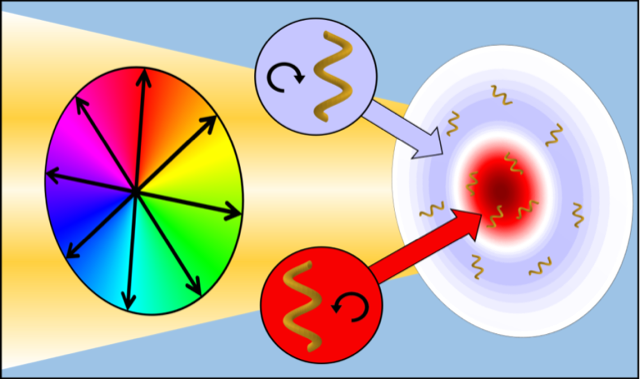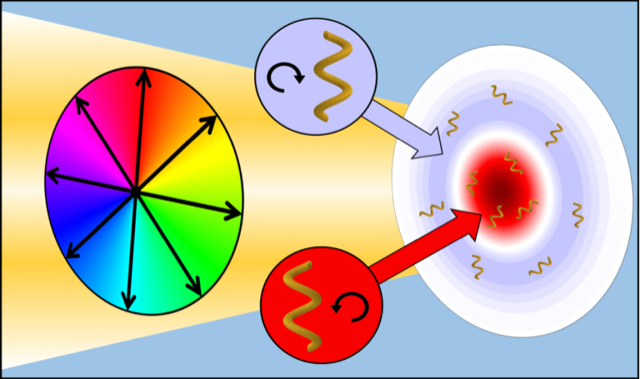Unpolarized Light Could Separate Chiral Molecules
Chiral molecules are mirror molecules that exist in left- and right-handed forms called enantiomers. In the drug industry, one enantiomer of a chiral molecule can be lifesaving, while the other can be deadly. But pharmaceutical manufacturers cannot generally choose which version is actually produced and instead rely on cumbersome sorting techniques to separate them post-production. Kayn Forbes and Dale Green, both physicists at the University of East Anglia, UK, have now determined in numerical simulations how to sort and trap chiral molecules using the angular momentum of an unpolarized laser beam [1]. The ability to sort enantiomers using all-optical methods would have a profound impact on the pharmaceutical industry.
Optical trapping, which was first demonstrated by Arthur Ashkin in 1970, uses optical scattering and gradient forces to manipulate micrometer-sized objects with high precision and accuracy. The basic principle is that radiation-pressure forces deriving from the optical linear momentum pushes particles in the direction of the beam propagation, while the optical gradient force draws particles to regions of high intensity within an inhomogeneous beam.
Selectively trapping a chiral molecule requires light with some sort of handedness, or chirality. “The importance of chirality of light comes from the peculiar way it interacts with chiral material objects,” says Andrea Aiello, a theoretical physicist at the Max Planck Institute for the Science of Light, who was not involved with this study. “It’s difficult to underestimate the importance of chiral light in material testing and pharmacology.”
The most natural choice for chiral light is circularly polarized light. Here, an electromagnetic wave has an electric field that rotates around the direction of propagation, tracing a helix in space that can be either left or right handed. A chiral molecule targeted with circularly polarized light responds differently to the left- and right-handed versions. Techniques have been developed to spatially separate one enantiomer out of a mixture using circularly polarized light.
Another option is to use shaped beams of light with orbital angular momentum (OAM). These beams, known as optical vortices or twisted light, have a helical structure that’s completely independent of the circular polarization. The twisting in OAM is related not to the electric-field direction but to the phase of the light, causing the wave front to have a spiral rather than a flat structure. Produced with simple lasers, the helical wave fronts of OAM light can transfer angular momentum and induce mechanical rotation in particle collections.
But until now, no optical-gradient-force trapping scheme has used OAM light. Because of their chirality and longitudinal component, Forbes argues, these helical beams should draw left- and right-handed molecules into different regions of high-intensity light—even when unpolarized. That it’s possible to produce chiral light-matter interactions with unpolarized light “goes against 200 years of classical optics,” says Forbes.
Previous work with OAM light did not show any chiral selectivity because the laser beams have typically been too large to manipulate small objects and molecules. “It’s like putting on a too big glove,” explains Forbes. A left-handed glove only fits on your left hand. But if the left-handed glove is ten times too big, it can fit your right hand as well. Similarly, the missing piece for optical tweezing was the scale of the beam relative to the trapped particle: a selective force requires the helical wave front to twist on a much tighter scale.
At the 2022 SPIE Photonics Europe conference, Forbes presented his proposal to focus the structure of an optical vortex right down to the molecular scale. “If you focus the beam waist down to within a couple of wavelengths of the light, it will work,” he says. Such tight focusing is now a routine process. Recent experiments, for example, have focused polarized beams to a waist size of two wavelengths. In numerical simulations, Forbes and Green explored this tight focusing with unpolarized light shaped into a vortex. Their results showed that the OAM light can separate chiral molecules into distinct concentric ring-shaped traps: one for left-handed enantiomers and another for right-handed ones.
“It’s a surprise that even unpolarized light might manifest chirality,” Aiello says. He explains that the key feature of the OAM light is the part of the electric field pointing in the direction of the beam propagation. If that field component is twisting—as it is in the researchers’ simulations—then the light will be able to separate chiral molecules.
Forbes believes that the first experimental test case will be with small, metallic particles shaped into left- and right-handed versions. These plasmonic particles exhibit extremely strong optical responses, so they should clearly separate into distinct rings. “In my opinion, it will be very easy to prove,” says Forbes. Once a proof of concept has been achieved, he believes that the method can be scaled down to molecules for drug application.
–Rachel Berkowitz
Rachel Berkowitz is a Corresponding Editor for Physics Magazine based in Vancouver, Canada.
References
- K. A. Forbes and D. Green, “Enantioselective optical gradient forces using 3D structured vortex light,” Optics Comms. 515, 128197 (2022).





